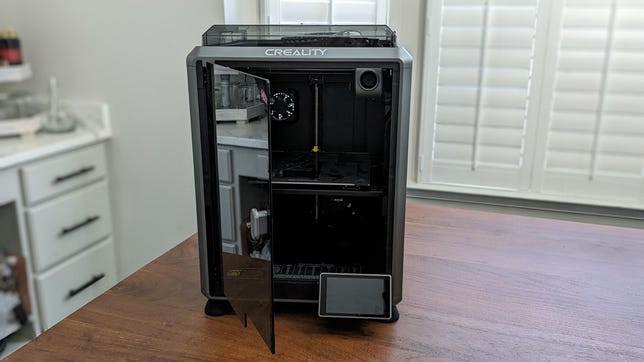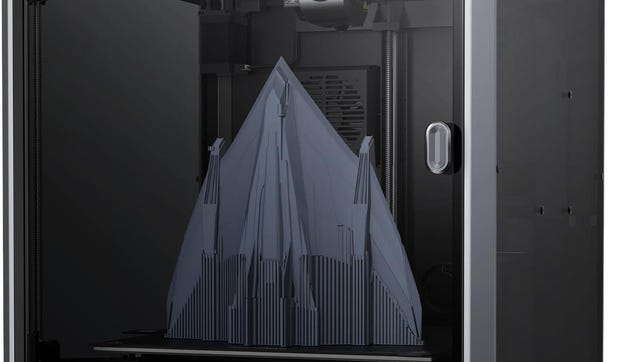Over the last year or so, 3D printing has taken a huge leap forward in speed. Creality is one of the biggest 3D printer manufacturers in the world, so it stands to reason it would make new printers to keep up with the latest trends.
Normally, Creality makes low-budget machines for entry-level users, so I was concerned that the K1 and K1 Max — the company’s new flagships — wouldn’t be able to play with the best fast 3D printers. I was wrong, though. The K1, especially the K1 Max, are solid entries into this new 3D printing world and worth your money.
Like
Large build plate
Great pricing
Very fast
Fantastic first layer every time
Don’t like
multiple failure points on filament feed
Poor slicer
While the K1 is Creality’s Flagship with a well-budgeted price tag and some fantastic features, the real winner of the pair is the K1 Max. The extra build volume, Lidar bed leveling and time-lapse camera elevate the K1 to a machine that I recommend to anyone looking to make large-scale props on a time crunch.

8.0
Creality K1
Like
Great price
Very fast
App supported
Don’t like
Slicer is not great
App is very ad heavy
The Creality K1 and K1 Max have the same overall build quality, though the Max has nicer finishes than the K1. The Max comes with a glass top rather than a plastic one, which adds to the premium feel. Of course, the Max has a larger build area, so it’s overall a larger machine, but almost all the other mechanical parts are the same as the K1.
Both machines are direct drive, fed from the back, and have the same hot end capable of temperatures around 300 degrees Celcius. Perhaps because of the extra size, I did have more trouble feeding the filament from the back of the K1 Max; it kept getting stuck inside the PTFE tube’s many kinks and curves. It wasn’t a deal breaker; a little wiggling usually fixed it, but I did kink the material a couple of times. Not ideal.
K1 and K1 Max Specifications
| Creality K1 | Creality K1 Max | |
| Build Volume | 220 x 220 x 250mm | 300 x 300 x 300mm |
| Hot end | Ceramic | Ceramic |
| Extruder type | Direct Drive | Direct Drive |
| Nozzle diameter | 0.4mm | 0.4mm |
| Nozzle max temperature | 300C | 300C |
| Build plate max temperature | 100C | 100C |
| Official max speed | 600mm/s | 600mm/s |
| Supported material | PLA, Hyper PLA, PETG, ABS, TPU | PLA, Hyper PLA, PETG, ABS, TPU |
| Auto bed leveling | Auto bed-leveling | Lidar AI-assisted bed leveling |
| Filament run-out sensor | Yes | Yes |
| Connectivity | USB dongle, WiFI, App app-controlled | USB dongle, WiFI, App app-controlled |
| Time-lapse camera | No | Yes |
| Slicer | Creality Slicer | Creality Slicer |
Setup on both machines was incredibly easy. These things are designed to be as plug-and-play as possible, and it shows. I went from lifting it out of the box to the first test print in under 5 minutes, including setting up the Wi-Fi and downloading the app on my phone.
A note on the phone app: While it’s great for keeping an eye on your print through the camera when using the K1 Max or just the control panel on the K1, Creality Cloud has had its fair share of detractors. The app has three major components: the workbench, where your physical printers can be monitored; the slicer, where you can upload models to be sliced and sent to the printer; and the library, where a store of models can be downloaded and printed. The workbench works incredibly well and lets you monitor every aspect of a printing machine. You can speed it up, pause it or tweak the fans to your liking as you print. It’s pretty great.
However, the other two parts of the app are a little more suspect. People across the 3D printing space are concerned that using the app allows Creality to use IP it doesn’t have permission for. This is a huge concern for the 3D modelers that originally made the model, as they could be missing out on revenue if Creality offers their work for free. I have avoided using these parts of the app because of this, though I did slice the CNET test print using the slicer to try it out, and it worked well.
Regarding build quality, the K1 and K1 Max are a mixed bag. Both are well constructed, but the finish leaves a little to be desired. The important parts like stepper motors, lead screws and belts are all well put together and don’t feel cheap. Then, when you look at the Creality logo and see it slapped on there crooked, as are several other stickers, it feels like some of the more human touches aren’t as well taken care of. Again, none of these cosmetic errors change how well it prints, but when you spend $600 or more for a product, you expect the logos to be straight.
Regardless of wonky logos, the K1 and K1 Max print extremely well. Gone are the days when you spent months modding your Creality Ender 3 to produce a good print; these things are fantastic out of the box. While Creality boasts a potential speed of 600mm/s, the practical speed limit I found was 300mm/s, which is still a massive improvement over 3D printers from just a year ago. Using Hyper Series PLA — a material with a high viscosity when melted so it can print faster — gives you the best result at such high speed, but even using PETG at 150mm/s gives incredible results. This dragon from Kijai Design was printed in PETG, and none of the details are lost, even at speed.
Both 3D printers did well on the CNET torture test, with the K1 Max slightly better than the K1. I think the Lidar-assisted bed leveling helped here, as all of the tolerance test sticks could be removed. These sticks are susceptible to binding on the first layer if it isn’t perfect, so very few printers succeed with all four. Both printers managed to have very little in the way of ringing, and the overhangs and bridging tests showed the K1 and K1 Max to be excellent, even at speed. Check out our best 3D printer list for more details on how we use this test.
The K1 Max, with its larger build area, is especially fun to play around with. The K1 is a decent machine, but it doesn’t stand out from the crowd like the K1 Max does. Having a fully enclosed printer that doesn’t take up a huge amount of room and that can print full-size cosplay helmets is amazing, and having a price below $1,000 makes it one to watch for anyone making outfits or armor.
Every model I printed, whether on the K1 or the K1 Max, turned out very well. At 300mm/s, some imperfections could be seen, but if you slowed everything down, say 150 to 180mm/s, and lowered the layer height, the prints were as good as anything I’ve done on machines like the MK3s+ from Prusa, the reigning king of 3D printers just two years ago. It’s a testament to how far the software and hardware have advanced in such a short time. Remember, 180mm/s is still three times faster than almost every printer available in 2021, so when I say “slowed everything down,” it’s a relative statement.
Whichever one of these 3D printers you are looking to buy, the low-cost K1 or the big ol’ K1 Max, you will get an excellent machine for the price. Creality has always made machines that needed tweaking to get good-quality models, but these two run great right out of the box.
If you have $900 and are trying to decide which one to get, the K1 Max is my choice. The extra smarts it offers, like Lidar bed leveling and a time-lapse camera, are great, but the 300 x 300 x 300mm build volume elevates the entire machine into greatness. If you have around $600, though? The K1 is a decent choice, though I think the Bambu Lab P1P is slightly better.





